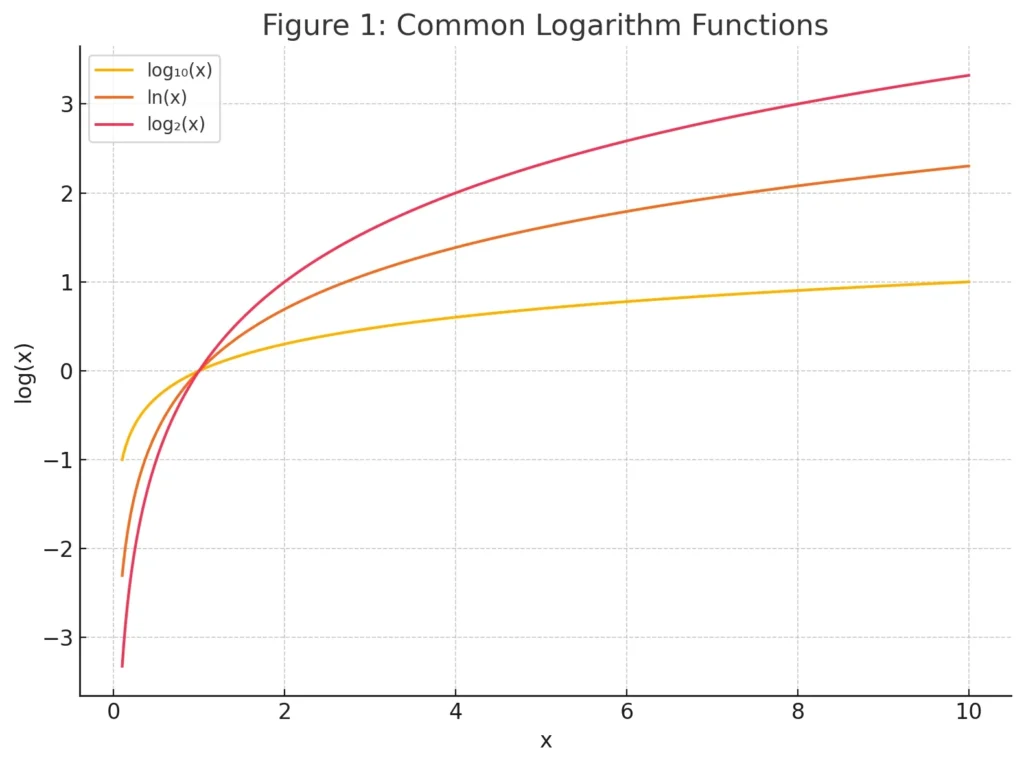Log Calculator: Solve for Log Base b of x
Solving for a logarithm can be complex, but it’s essential for many fields, from science to finance. Our simple Log Calculator gives you an instant, accurate answer whether you’re working with a common log, natural log, or a custom base.
Logarithm (Log)
Solves for any unknown in the equation logb(x) = y. Provide any two values to calculate the third.
Solution
Step-by-Step Solution

How to Use Our Log Calculator
Our calculator is designed for simplicity and accuracy. Here’s what each field means:
Number (x): This is the number you want to find the logarithm of. It must be a positive number.
Base (b): This is the base of the logarithm. It must be a positive number and cannot be 1. For a common log, use base 10. For a natural log (ln), use base “e” (our calculator has a button for this).
Calculate: Once you’ve entered your number and base, click this button to get your result.
Understanding Your Results
The calculator solves the logarithm equation: log_b(x)=y
The result, ‘y’, is the exponent you must raise the base (b) to in order to get the number (x). In other words, the logarithm is the inverse operation of exponentiation.
The relationship can be expressed like this:
If log_b(x)=y, then by=x
Example:
If you use the calculator to find log_10(100), the result will be 2.
This is because you need to raise the base 10 to the power of 2 to get the number 100.
102=100
The result is the exponent that solves the problem. Our calculator handles this instantly for any valid numbers you enter.
Key Logarithm Properties & Rules
Understanding the fundamental properties of logarithms can help you simplify complex problems even without a calculator. Here are the most important rules:
| Rule Name | Formula | Explanation & Example |
| Product Rule | log_b(McdotN)=log_b(M)+log_b(N) | The log of a product is the sum of the logs of its factors. Example: log_3(9cdot27)=log_3(9)+log_3(27)=2+3=5 |
| Quotient Rule | log_b(fracMN)=log_b(M)−log_b(N) | The log of a quotient is the difference between the logs of the numerator and the denominator. Example: log_2(frac328)=log_2(32)−log_2(8)=5−3=2 |
| Power Rule | log_b(Mp)=pcdotlog_b(M) | The log of a number raised to a power is the power times the log of the number. Example: log_10(1003)=3cdotlog_10(100)=3cdot2=6 |
| Change of Base | log_b(x)=fraclog_k(x)log_k(b) | You can convert a log of one base to a log of any other base (k). This is useful for calculators that only have log (base 10) and ln (base e) buttons. <br> Example: To find log_7(49), you could use a base 10 calculator: fraclog_10(49)log_10(7)=frac1.69020.8451approx2 |
Frequently Asked Questions
What is a logarithm?
A logarithm is essentially an exponent. When you see “log_b(x)“, it’s asking a question: “What power do I need to raise the base ‘b’ to in order to get the number ‘x’?” The answer to that question is the logarithm. It’s the inverse operation to exponentiation.
What’s the difference between log and ln?
The difference lies in the base.
logtypically implies a common logarithm, which has a base of 10. This is written as log_10(x). It’s widely used in fields like chemistry (pH scale) and engineering (decibel scale).lnrepresents the natural logarithm, which has a base of Euler’s number,e, an irrational constant approximately equal to 2.71828. This is written as log_e(x). Natural logarithms are fundamental in calculus, physics, and finance for modeling continuous growth and decay.
| Feature | Common Logarithm (log) | Natural Logarithm (ln) |
| Base | Base 10 | Base e (≈ 2.71828) |
| Notation | log(x) or log_10(x) | ln(x) |
| Inverse | 10x | ex |
| Primary Use | Measuring magnitude (pH, decibels, Richter scale) | Modeling continuous growth/decay (compound interest, population growth) |
Where are logarithms used in real life?
Logarithms aren’t just for math class; they describe many phenomena in the real world.
Measuring Earthquakes (Richter Scale): The Richter scale is logarithmic. A magnitude 7 earthquake has 10 times the shaking amplitude of a magnitude 6 quake.
Sound Intensity (Decibels): The decibel (dB) scale for sound is logarithmic. A 20 dB sound has 10 times the intensity of a 10 dB sound.
Chemistry (pH Scale): The pH scale measures acidity. A substance with a pH of 4 is 10 times more acidic than one with a pH of 5.
Finance (Compound Interest): Logarithms are used to determine how long it will take for an investment to reach a certain value with continuous compounding.
Why can’t you take the log of a negative number or zero?
This goes back to the definition of a logarithm. Remember, log_b(x)=y is the same as by=x. The base ‘b’ must be a positive number.
Negative Number: There is no real exponent ‘y’ that you can raise a positive base ‘b’ to that will result in a negative number ‘x’. For example, try to solve 2y=−4. It’s impossible.
Zero: Similarly, there is no exponent ‘y’ you can raise a positive base ‘b’ to that will result in zero. You can get incredibly close (e.g., 10−100), but you can never actually reach zero.
What does a logarithm of 1 mean?
The logarithm of 1 with any valid base is always zero.
log_b(1)=0
This is because any positive number ‘b’ raised to the power of 0 is equal to 1 (b0=1).
How do I calculate a log with a base that’s not 10 or e?
That’s exactly what our calculator is for! You can enter any valid positive number as the base. However, if you’re using a standard scientific calculator without this function, you must use the Change of Base Rule.
Concrete Example: Let’s calculate log_5(625) using a calculator that only has log (base 10).
Use the formula: log_5(625)=fraclog_10(625)log_10(5)
Calculate the top part: log_10(625)approx2.7959
Calculate the bottom part: log_10(5)approx0.6990
Divide: frac2.79590.6990=4
So, log_5(625)=4. (Which is correct, since 54=625).
What is an antilogarithm?
An antilogarithm (or antilog) is the inverse of a logarithm. It means finding the number ‘x’ if you know the base ‘b’ and the logarithm ‘y’. In simpler terms, it’s just exponentiation.
If log_b(x)=y, then the antilog is finding x, which is by.
Example: Find the antilog of 3 for base 10. This is asking: log_10(x)=3. To solve for x, you just calculate 103, which is 1000.
Can the base of a logarithm be a fraction?
Yes, the base can be a fraction (as long as it’s positive and not equal to 1). For example, log_1/2(8) is a valid logarithm.
It asks the question: “To what power must I raise frac12 to get 8?” The answer is -3, because (frac12)−3=(frac21)3=23=8.
What is Euler’s number (e)?
Euler’s number, e, is a special mathematical constant approximately equal to 2.71828. It’s an irrational number, meaning its decimal representation never ends or repeats. It appears naturally in situations involving continuous growth or decay, making it the perfect base (the “natural” base) for logarithms that model these processes, such as compound interest, radioactive decay, and population growth models.
How is this different from an exponent?
Logarithms and exponents are two sides of the same coin—they are inverse operations.
Exponentiation starts with a base and an exponent and asks for the result: 34=? (Answer: 81)
Logarithm starts with a base and the result and asks for the exponent: log_3(81)=? (Answer: 4)
Now that you’ve mastered logarithms, explore the inverse operation with our Exponent Calculator. You can also perform these calculations and many more using our full-featured Scientific Calculator.
Creator

